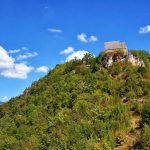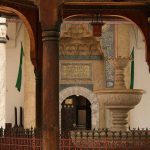Sarajevo has the luck to be surrounded by hills, and Sarajevo hills have the luck to be spread by mahalas[1]. Mahalas have the luck to be able to view Sarajevo. And where are we in that outburst of luck? We are lucky to be able to walk through mahalas, to climb up the hill and watch Sarajevo. If we can and know how. With love
 Written by: Vedran JAKUPOVIĆ
Written by: Vedran JAKUPOVIĆ
We can view Šeher[2] from Vratnik’s right or Bistrik’s left side. Lately, with the construction of high rises, Šeher got the view from a terrace, “by Miljacka”.
Special view with a special dessert
After prince Eugene of Savoy’s arson of Sarajevo, Vratnik’s town was girded by walls. One had to pass three gates to enter Vratnik, and forts were additionally fortified by Sarajevo’s tabijas[3], five of them. Nowadays, of those five tabijas four got their cafés and taverns with a view of the city. Only Strošić tabija still awaits its laird.
 Under the Arnaut tabija wall, where „Das ist Walter“ Jajce barracks are, there is a little café Kamarija – point of view. Kamarija is a sort of mahala doksat[4]. In kamarija you look up the street, down the street and at the Moon (kamer), and nobody can see you. This kamarija looks at the city. As much as it looks at the city, kamarija itself can be seen from Čaršija[5]. It seems to be floating above the rocks at the gradients of tabija walls. It is only when you sit at the terrace that you can see how much the lush acacia and ash tree forest, in which Kamarija was built, gives the shade to its guests, as well as the support to the building itself. With the special view goes the special dessert and natural quince juice. The quince shrinks the mouth somewhat, but a man in such a place should have his mouth shrunk and his eyes wide open.
Under the Arnaut tabija wall, where „Das ist Walter“ Jajce barracks are, there is a little café Kamarija – point of view. Kamarija is a sort of mahala doksat[4]. In kamarija you look up the street, down the street and at the Moon (kamer), and nobody can see you. This kamarija looks at the city. As much as it looks at the city, kamarija itself can be seen from Čaršija[5]. It seems to be floating above the rocks at the gradients of tabija walls. It is only when you sit at the terrace that you can see how much the lush acacia and ash tree forest, in which Kamarija was built, gives the shade to its guests, as well as the support to the building itself. With the special view goes the special dessert and natural quince juice. The quince shrinks the mouth somewhat, but a man in such a place should have his mouth shrunk and his eyes wide open.
 At the exit of Vratnik town, below tabija Zmajevac, there are still remnants of the wall which girded and shielded the city. A drinking fountain was built into the wall, and the wall itself protects not the city anymore, but the flower pots, and it does not divide Vratnik town from Sedrenik and Ravne Bakije, but two parts of the Vidikovac café in Zmajevac. This is the highest point of Vratnik and a place where the view does not end at Čaršija, but stretches around the entire Sarajevo, to Ilidža, Igman, and when the weather is good, further to the West. It is especially interesting to envelop in one view the City Hall and Marijin dvor and the airplane that is landing in Sarajevo airport. Younger hedonists will smoke hookas while viewing Šeher, and the older ones are happy enough with coffee, short and strong one.
At the exit of Vratnik town, below tabija Zmajevac, there are still remnants of the wall which girded and shielded the city. A drinking fountain was built into the wall, and the wall itself protects not the city anymore, but the flower pots, and it does not divide Vratnik town from Sedrenik and Ravne Bakije, but two parts of the Vidikovac café in Zmajevac. This is the highest point of Vratnik and a place where the view does not end at Čaršija, but stretches around the entire Sarajevo, to Ilidža, Igman, and when the weather is good, further to the West. It is especially interesting to envelop in one view the City Hall and Marijin dvor and the airplane that is landing in Sarajevo airport. Younger hedonists will smoke hookas while viewing Šeher, and the older ones are happy enough with coffee, short and strong one.
The beginning of merak[6]
The arrival to Vidikovac itself can present an adventure. To fit people we recommend starting from Čaršija via Kovači, straight to Ploče, right ahead up the hill to Strošić tabija, and then further uphill by the wall to Vidikovac. Those who survive will have a tale to tell… And enjoy.
On Bistrik side, the first viewing stop is the old railway station. It is a building that dominates the transit with its beauty. Bistrik station is also a crossroad that leads to two ideal spots for coffee with a view.
 Left to the East and Miljacka canyon there is a Café Liberty by the road. It dominates above Alifakovac and provides view, at an strange angle, at Čaršija’s core, Vratnik, but also Bistrik. Especially fascinating is the pre-dusk view at Brdo mosque, if only as an alternative to look at after one tires of looking at other directions. The fence on the terrace is made of glass and thus does not spoil the atmosphere, and as addition to coffee and the view, they offer frequent performances by top musicians. Their quality is sure to satisfy even the pickiest of music fans.
Left to the East and Miljacka canyon there is a Café Liberty by the road. It dominates above Alifakovac and provides view, at an strange angle, at Čaršija’s core, Vratnik, but also Bistrik. Especially fascinating is the pre-dusk view at Brdo mosque, if only as an alternative to look at after one tires of looking at other directions. The fence on the terrace is made of glass and thus does not spoil the atmosphere, and as addition to coffee and the view, they offer frequent performances by top musicians. Their quality is sure to satisfy even the pickiest of music fans.
Up the hill from Bistrik station, past restaurant Park Prinčeva, and at the once a shooting polygon of Ottoman army called Nišan, there is one of the oldest cafés in Sarajevo. Mjesto kod Bibana (Biban’s
[1] Old-fashioned town quarters with narrow streets and rowed houses with front gardens
[2] Turkish (from Persian) for city, also another name for Sarajevo in Sarajevo jargon
[3] Fort, stronghold
[4] Tur., type of balcony, usually on first floor, customary in islamic architecture
[5] Turkish (from Persian) for town square, market, street with shops and workshops; short for Baščaršija, Sarajevo’s old town
[6] Pleasure derived from simple joys, such as spending time feasting and merrymaking




